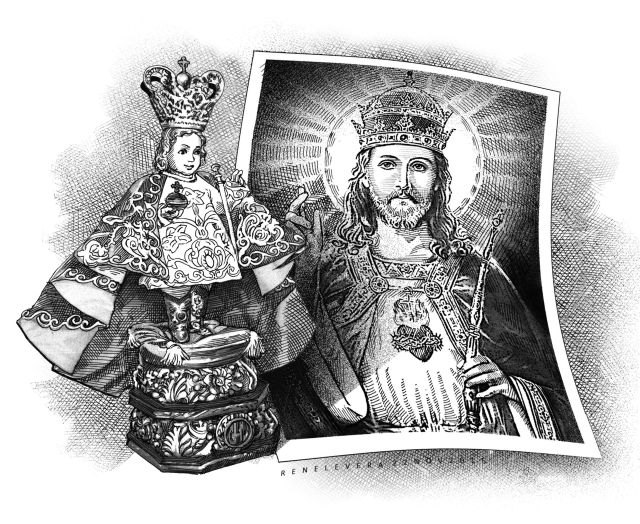
When we had our old house put back into a better state, the wife made sure that we would have a niche in a corner of the living room for the statuettes of Jesus, Mary and the saints. A Catholic home could not do without these figurines. We had accumulated quite a number, some procured during fits of devotion, others reaching us as gifts from friends, or as heirlooms, every piece of which reminded us of its provenance, serving as index to a particular moment in family history.
I remember an antique painting of St. Anne, the mother of the Blessed Virgin Mary, which Mother had intended to give to me, but which someone sold without her knowledge. Time had all but erased the image of St. Anne, and would have altogether succeeded if Mother had not moved the painting to a place with a less ruinous light and air. Unfortunately, someone else continued the translation and moved the painting some more, out of sight, for filthy lucre.
Since I mentioned a lost heirloom, I might as well say a few words of regret about another item of the kind – a little ivory Sto. Niño that had claimed the central space of every single one of the many altars of my boyhood. Which figure, out of reverence for the Holy Child, I never missed kissing whenever within reach, a gesture that provoked a cousin, a Protestant, so young and yet so bigoted, to snatch the little statue and rub it against his ass, an uncalled for act which I considered sacrilegious, and which promptly earned him a punch.
Upon the wife’s instructions, the carpenter built into a corner a pedestal with five open shelves. Generic angels went into the lowest shelf, and to the next an angel of justice, holding a sword and a balance, and another angel with a fish and a shepherd’s staff – the angel Raphael, Mother said.
The third level has a gold-colored figure of Our Lady of Manaoag and behind her, a larger statue, that of St. Pedro Calungsod, the second Filipino saint and a Visayan, whose canonization at St. Peter’s in Rome the wife and I attended.
On the level above this stand the figures of Our Lady of Lourdes and, kneeling, of St. Bernadette Soubirous, together with a tiny San Damiano cross, and three cruciform palm leaves blessed on Palm Sunday.
A crèche, a representation of the Nativity scene, fills up most of the next level, the second to the last. Of late, because of the imminence of the Christmas season, this has received much of the wife’s attention, and now has on each of its sides a vase of pink roses.
The topmost level contains only one figure, the figure of Christ the King – Jesus seated on a throne, his hand raised in judgment, his Sacred Heart in evidence. I consider the wife’s placement of the statue most proper, if only because it has reached our home from her own family, which gave it prominence, having it enthroned at the entrance of their house, and prayed the communal rosary before it whenever their turn to host it came around.
The Church celebrates the feast of Christ the King on the last Sunday of the liturgical year, and chooses for the Gospel reading the passage from the Gospel of John, in which Pilate asked Jesus, “Are you the King of the Jews?” To which, in due course, Jesus answered, “My kingdom does not belong to this world. If my kingdom did belong to this world, my attendants would be fighting to keep me from being handed over to the Jews. But as it is, my kingdom is not here.”
Pilate pressed him — “Then you are a king?” — and Jesus answered, “You say I am a king. For this I was born and for this I came into the world, to testify to the truth. Everyone who belongs to the truth listens to my voice.”
The statue on the topmost shelf reminds me of this passage. Surely, the wife, who I think has done a theologically sound arrangement of images – which by the way Catholics do not worship but merely consider and respect as representations of Jesus, Mary, the angels and the saints, and use as aids to remain focused in prayer and meditation – intends to declare that our household belongs to Christ, to the reign of truth, to Truth himself.
Jesus said that his kingdom does not belong to this world. I see here a play on “world,” and recall that, as Paul Éluard said, “There is another world, and it is this one.”
Disclaimer: The comments uploaded on this site do not necessarily represent or reflect the views of management and owner of Cebudailynews. We reserve the right to exclude comments that we deem to be inconsistent with our editorial standards.
